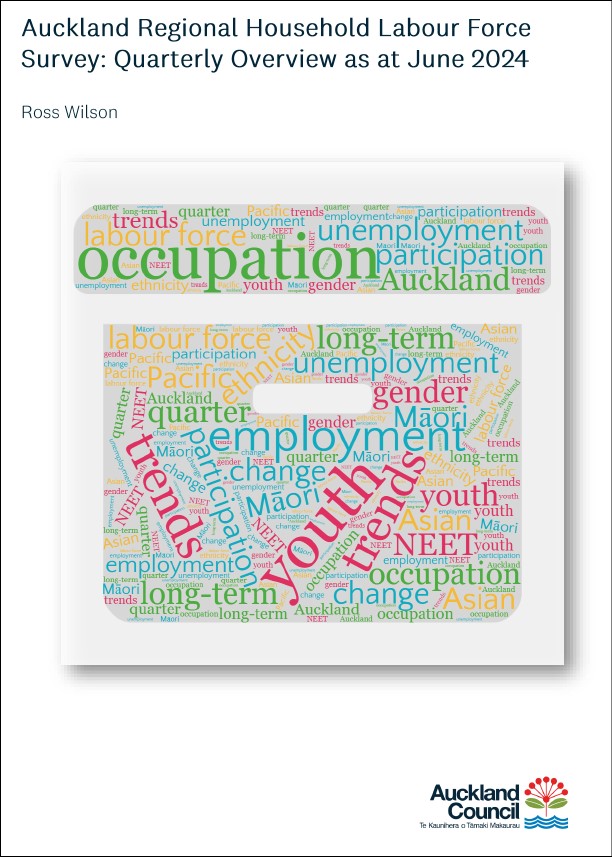Auckland regional household labour force survey: quarterly overview as at June 2024
Author:
Ross WilsonSource:
Auckland Council Policy Department | Statistics New ZealandPublication date:
2024Topics:
EconomyAn overview of labour force participation in Auckland, as indicated by results of Stats NZ's quarterly Household Labour Force Survey. HLFS
Overview and highlights
For the June 2024 quarter, compared to the preceding quarter (March 2024):
- Auckland’s unemployment rate was 4.6%, slightly lower than 4.8% in March 2024, (and lower than nearly all of 2009 to 2020).
- The number of people who were unemployed fell slightly to 48,500 (-1,800, up 4%).
- The number of people employed rose slightly to 1,007,700 (+4,000, a 0% increase).
- The number of people not in the labour force (NILF) rose to 383,600 (+6,600, up 2%).
- The labour force participation rate (LFPR) fell to 73.4%, the second-highest June quarter on record (since at least 1995). LFPR since 2021 have been at record levels.
In addition, for the June 2024 quarter:
- The rate of people aged 15 to 24 not in employment, education or training (NEET) was 13.0%, slightly above the rest of New Zealand (11.4%).
Over the year ended June 2024, compared to the year ended June 2023:
- The unemployment rate averaged 4.4%, higher than a year earlier (2023: 3.4%).
- The unemployment rate increase was highest for young people aged 15 to 19 (+6.1% to 21.0%) and 20 to 24 (+2.3% to 8.7%), and to a lesser extent ages 55 and over (+0.8% to 2.9%), but also affected 25 to 39 (+0.5% to 3.5%) and 40 to 54 (+0.6% to 2.5%).
- The unemployment rate for females averaged 4.9%, above the previous year (3.9%). The rate for males averaged 3.9% (above 3.0% a year prior), so the gap between males and females (1.0%) remained similar to the 20-year average (0.8%).
- Unemployment rates varied between the main ethnic groups, but rose for each of them: Māori (9.7%, up from 7.6%), Pacific peoples (8.2%, up from 6.4%), European (3.6%, up from 2.4%), and Asian (3.5%, up from 3.1%).
- The labour force participation rate (LFPR) averaged 73.9%, slightly lower than a year earlier (74.2%) but remaining higher than any time before 2023.
- The LFPR fell only for females (69.2%, down 0.5% from 69.7%) and was unchanged for males (78.8%); the differential rose (to 9.6%), but has halved since 1995 (19.0%).
- Labour force participation rates fell for those aged 15-19 (down 4.7% to 44.0%) and 20 to 24 (down 2.4% to 79.5%), and had slight changes for ages 25-39 (88.3%, up 0.7%), ages 40-54 (88.4%, down 1.0%) and ages 55+ (52.2%, down 0.2%)
- Labour force participation rates by ethnic group fell slightly for Pacific peoples (66.0%, down 1.5%), with minimal changes for Māori (69.2%), European (75.0%) and Asian (77.4%). All main groups have been at or near record levels since 2022.
In addition, over the year ended June 2024:
- The annual average NEET rate for Auckland was 12.6%, slightly above the rest of New Zealand (12.6%), and slightly above the year ended June 2023 (11.1%).
- Auckland NEET rates were highest for Māori (23.3%) and Pacific (18.5%) ethnicities, and for the Southern Initiative area (20.4%).
- Auckland’s NEET rate was higher for those aged 20-24 (15.1%) than 15-19 (10.1%).
Overview published August 2024.
